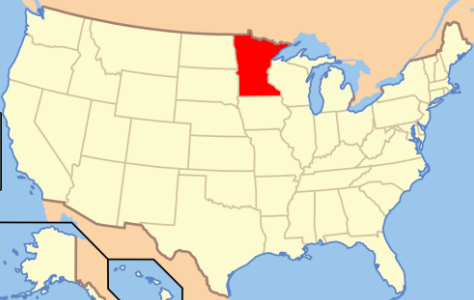Interview with Natalie
Natalie Ringsmuth is the founder and director of Unite Cloud. She grew up in Sauk Rapids, Minnesota and has a degree in Music Education from Concordia Moorhead. For a while, she taught a middle school choir in Georgia. She now works with Unite Cloud, works in an immigration law office, and is the Vice-Chair of the Stride Academy school board. In her very little free time, she loves to spend time with her three kids and husband. This interview provides valuable information on what hate groups are, personal stories of dealing with hate, and ways to combat it.
In the work that you do, do you often come across hate groups? If so, how many do you know of?
The Southern Poverty Law Center actually keeps track of how many hate groups exist around the nation. In Minnesota, there are about 5-7 (there are actually 10) recognized and organized hate groups, one of them being in Central Minnesota. I believe it is a white supremacy group. We believe people in this group travel to St. Cloud, and are the folks who usually have pickup trucks with the confederate flag waiving in the back and have been known to travel around heavily populated east African areas yelling the “N-word” or “Get out of our country, this is our country,” late at night. Also, lately there have been incidences of posters being put up at St. Cloud State saying things as “Being white is ok” or “Refugees not welcome.”
There is [another] group that maybe the Southern Poverty Law Center would consider a hate group, but are really doing undermining work here in Central Minnesota. One of the groups is called “Peace in St. Cloud” and are a part of the groups who bring in anti-Islamic speakers. I have met with a lot of these speakers, and they all say the same thing, “At some time all Muslims are going to wake-up and behead all of your children and grandchildren.”
Do you know, or do you study any psychology associated with rising in power and hate?
I personally don’t, but we have a speaking team and [one of the people on that team is] Aref Hassan. He is a professor at St. Cloud State. He specifically deals with terrorism, also kind of what you’re talking about: How did it come [to be] that in Saudi Arabia for instance, you and I in the 70’s could probably walk the streets wearing what we are wearing now, but now, women can’t drive and have to walk the streets wearing a hijab. He can explain that rise and how it has evolved throughout history, and what the perfect mix is to make this happen. In his mind, it isn’t any different to what is happening in the United States. With the current president we have in office who is working to enforce racist executive orders, especially immigration orders, that is the path it takes to get to the point where there is enough support for something like this.
Back in early November, St. Cloud City Council had a meeting that was discussing a possible refugee ban to be put in place in St. Cloud. City Council member Jeff Johnson proposed this ban and lost in a 6-1 vote. You can read the full story here.
What was Unite Cloud’s reaction to what happened with the St. Cloud City Council proposed refugee ban?
I have actually been following Jeff Johnson for about 2 years now. I was extremely concerned about some of his rhetoric. I basically sat across a table from him and told him he is using his power for things that aren’t ok. You are allowing yourself to be taken in by these groups of people who only care about “whiteness” and what central Minnesota used to be like. I have talked to him Christian to Christian and said, “This is not what our faith is about” and at that time we couldn’t come to an agreement of what would be the next step. He decided to continue what he was going to do. From then he really degraded, we were at a hearing in Stearns County. They actually first started to do this in Stearns County. He was the leader of that with the Stearns County commissioners and that led to the Stearns County report in 2015. [This report] showed that immigration refugee services were only 0.7% of the full budget. That wasn’t good enough for him, so he decided to take it to St. Cloud City Council. We had about 300 citizens show up and most of them were people hold signs saying “All are welcome,” so that was reassuring. It is kind of cool that there were actually people all over the nation watching, so it was big for not only Minnesota but all over the nation. I think people are realizing what indifference looks like.
Why is central Minnesota such a large hub for refugees to immigrate to?
It was a primary resettlement area for Lutheran Social Services, but that doesn’t really answer the question because that is roughly only 240 people settling here each year. Although about a ⅓ actually resettle in Kandiyohi County, which is Willmar, MN. I have a refugee friend who was immigrating from Kenya to Alaska. While he was at the Minneapolis airport, he had some Somali brothers welcome him and were excited he made it to Minnesota. He told them he was actually going to Alaska and stayed there for some time because he had family there. He ended up moving to Minnesota years later to stay with family and friends here.
It really boils down to the fact that when someone moves from home, they want to move somewhere where someone will speak the same language as them, dress like them, worship like them, etc.—that is just human nature. It isn’t necessarily as welcoming as we would like it to be, but you can at least be around people who are similar to you.
What kind of hands-on work does Unite Cloud do in terms of abolishing stereotypes?
The main thing that we do is passive education; we have kind of coined the terms “passive” and “active” education. We find that, again, because people are so indifferent, people like you and I could leave this conversation really whenever we want to. I can go about with my white, middle-class, Christian life, and walk among this land unharmed and often not discriminated. However, we had to find a way to break down the walls. By passive I mean: People won’t go from being indifferent to showing up at one of our events, so how do we build that bridge? The main part of our bridge is our online presence and our blogs. Our blogs are huge, and we having been doing them for about two and a half years now. Some people have told us that because they continue to read our blogs, after two-years, they decided to come to one of our events. “I want to learn more about my neighbors” is what they often say. The point is saturation of the market, so when you’re on your couch, relaxing, about to watch Netflix, you scroll through Facebook and see something about an undocumented immigrant who is now in the National Guard. “When did this happen? How did this happen?” So that is our bridge in passive education. Our other is through our new exhibit we are starting. There are banners, like the ones you might see at health fairs, with stories about refugees and their lives back home and how they have made this their home. They would be displayed in schools and public areas.
It is called Green Card Voices and you can read one testimony here. The Green Card Voices exhibit will be displayed for the first time at Whitney Senior Center in St. Cloud on January 5th. More information here.
You mentioned earlier that you have a Unite Cloud speaking team. What do those speaking events look like?
We do things like going to high school social studies classrooms and teaching students about the history of immigration. The whole point of presenting to students is the ability to facilitate conversation. We want people to have a conversation with us more than anything. Our goal is to change sympathy to empathy, and indifference to action. We do this through certain activities and teaching that there are negative consequences to being silent about indifference. We even have workshops for students, with such topics as Immigration, Refugees and the Law, Stories of Faith Amidst Changing Demographics, and What is it Like to be a Refugee (Elementary, Middle, High School).
Regarding what you support and the work that you do, do you experience any form of hate towards you?
FOR SURE! All of the time…on the regular. Actually, last year, on the day after Christmas, my seven-year-old daughter came up to our room saying “Mommy it’s really cold downstairs!” I told her “It’s ok dear, we live in Minnesota,” but she was certain something was up. I came downstairs to see that our front porch door had been smashed in. We had one of the “Love your neighbor” signs on the door and that had been completely smashed in with ice chunks. On some level, it wasn’t surprising to my husband and myself, but this was the first time my kids felt that they were endangered. From that moment on for the next six months, she couldn’t sleep alone and was having nightmares constantly. She knew immediately that the people who did this, did this because they don’t support what we support. She never ever said, “Don’t do it anymore Mommy!” or anything. It was just hard to tell her subconscious that she was safe here.
Does this give you, at all, a sense of empathy for minority groups being discriminated?
Only in the slightest bit…when you hear some of the stories of these refugees, they are just sickening. I know of one woman’s story who told me that she saw her husband and sons lined up and shot at point blank, and then her daughters and herself were raped. I can’t imagine what it must be like for her to sleep at night. If myself or my kids have a hard time sleeping at night, it’s hard but incomparable to that. However, it is a powerful message for my daughter to keep persisting.
How can students get involved?
Yay! That is a great question! One thing I really love to see is student bloggers. I know it is hard to fit it into your busy schedule but I think it is the most powerful to see adolescents voice their stories. It is also difficult to be as truthful about what is happening in schools, but honestly, that is the only way things are going to change.



